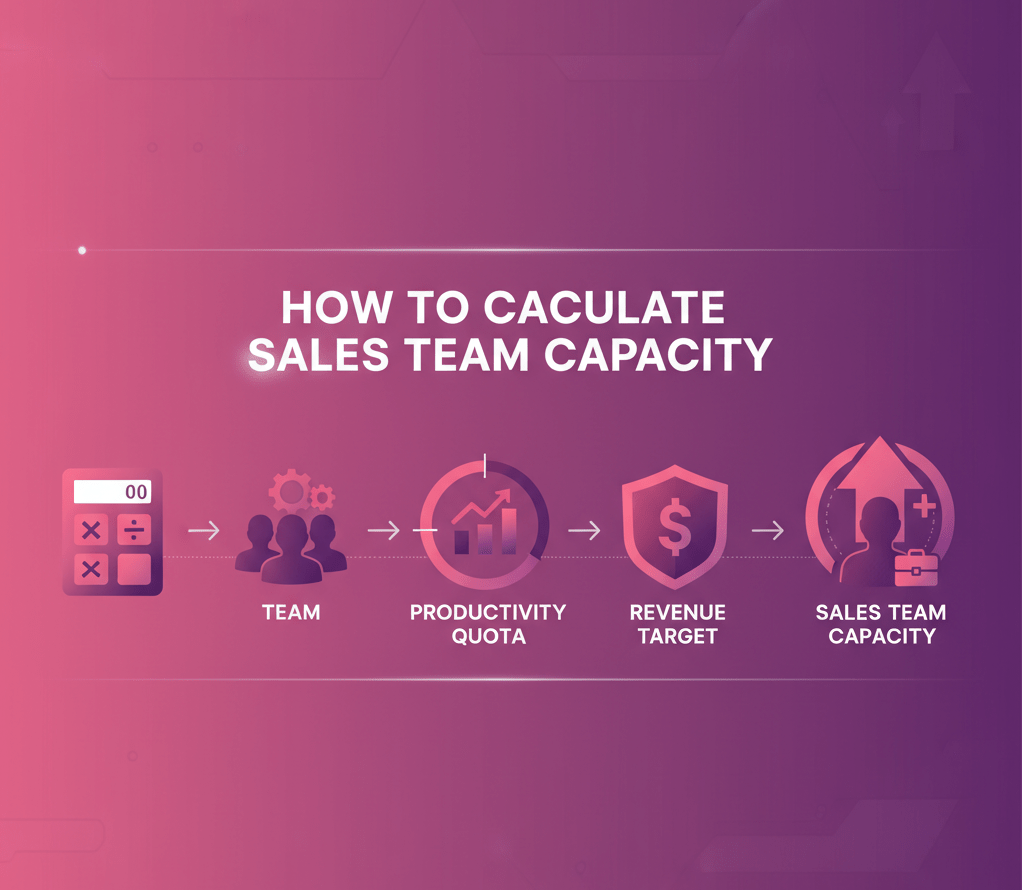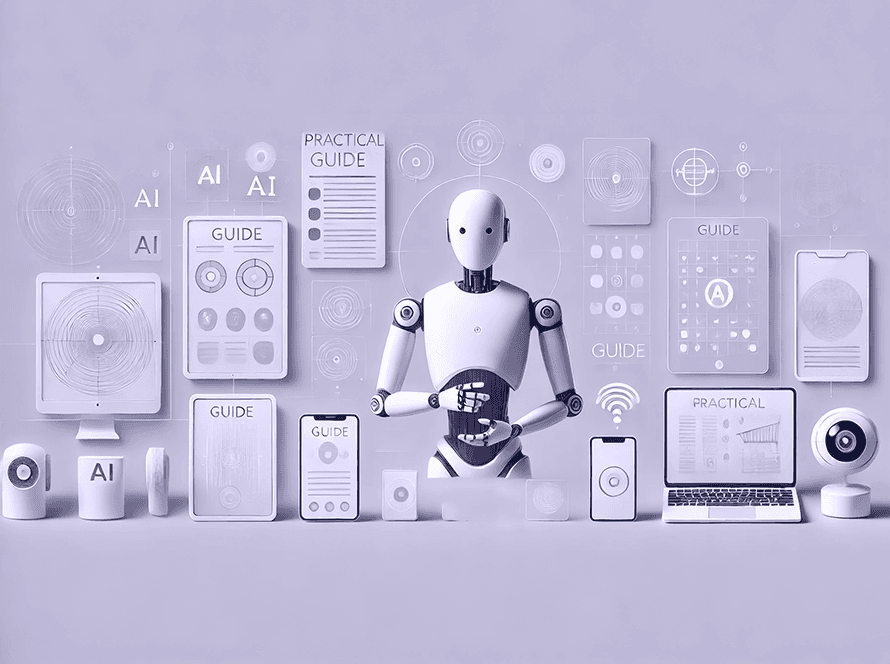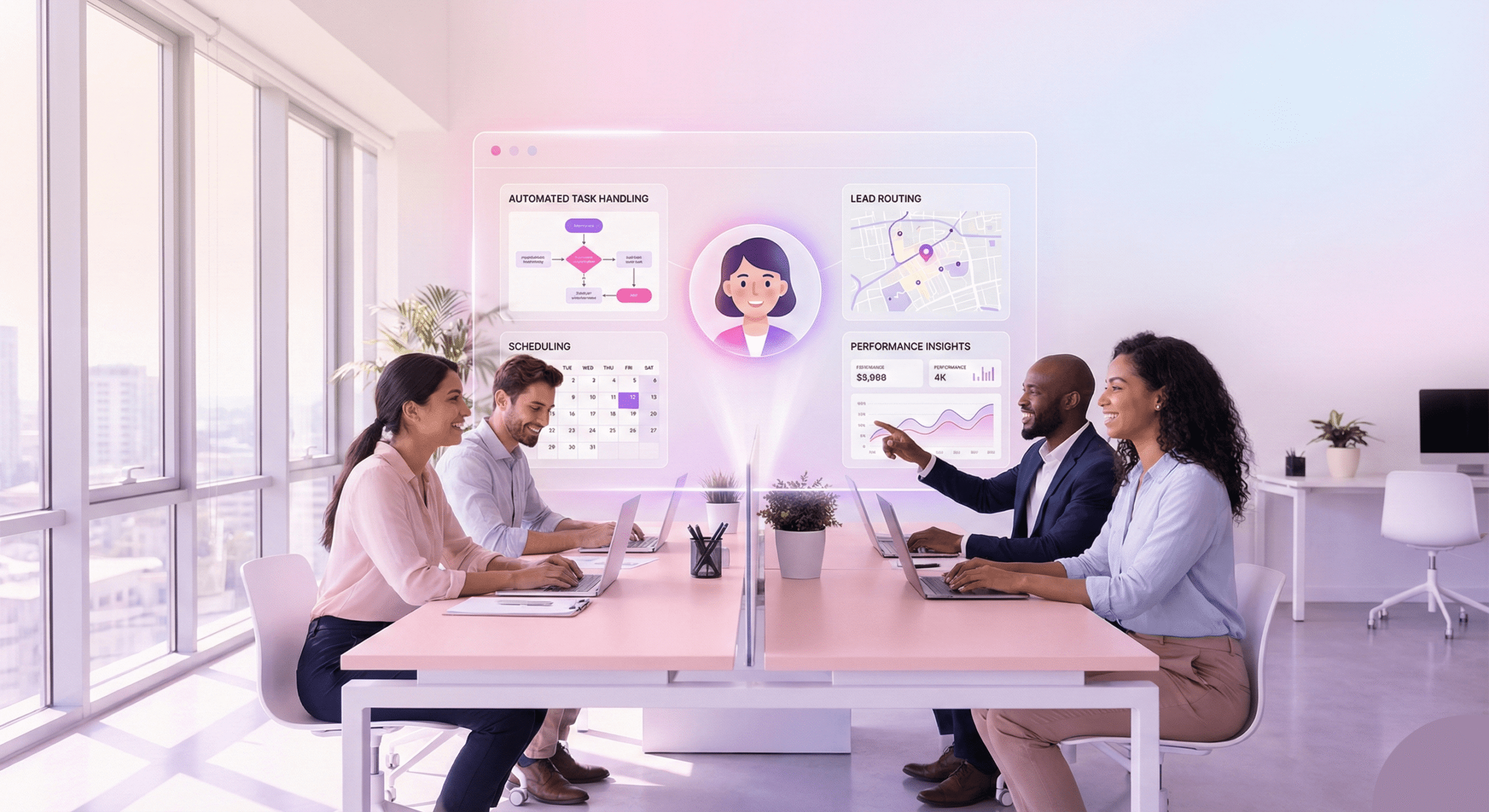“Learn how to Calculate Sales Team Capacity, then use AI to offload non-selling tasks, doubling your true selling hours and growing revenue without hiring new staff.”
Let’s talk sales. Specifically, let’s talk about getting more sales without spending more on salaries. It’s the dream, right? Every sales manager wants to grow revenue, but adding new hires always comes with a hefty price tag. What if you could squeeze more out of your existing team? Not by pushing them harder, but by making them more innovative and more efficient. That’s where AI comes in. This isn’t about replacing your team. It’s about empowering them. It’s about giving them superpowers so they can focus on what they do best: selling.

Understanding Your Sales Team’s True Capacity: More Than Just Headcount
Before we even talk about AI, we need to understand your current situation. How much can your sales team really produce? It’s a critical question, and the answer isn’t as simple as counting heads. Many sales managers underestimate their team’s actual capacity because they fail to account for all the time-consuming tasks that are not directly related to selling. We call these “non-selling activities.”
Think about it. Your sales reps are spending hours every week on things like:
- Prospecting: Digging through LinkedIn, searching databases, trying to find the right contacts.
- Qualifying Leads: Making initial calls, sending emails, and trying to figure out if a lead is even worth their time.
- Scheduling Meetings: The endless back-and-forth emails, calendar juggling, and dealing with no-shows.
- Administrative Tasks: Updating CRMs, writing notes, and preparing reports.
These tasks are necessary. They are part of the sales process. But they steal valuable time from actual selling. They reduce your sales team’s capacity. If you want to know how to calculate sales team capacity, you need to start by auditing these non-selling hours.
The Sales Capacity Planning Audit: Where Does the Time Go?
Let’s break down how to truly understand where your team’s time is going, truly. This isn’t a glance. This requires a proper audit. You need to get granular.
Step 1: Define Core Selling Activities vs. Non-Selling Activities.
- Core Selling Activities: These are the actions that directly lead to a deal.
- Conducting product demos.
- Presenting proposals.
- Negotiating terms.
- Closing deals.
- Building relationships with active prospects.
- Non-Selling Activities: Everything else that supports the selling process but isn’t direct interaction with a ready-to-buy prospect.
- Initial lead research.
- Cold calling (initial contact).
- Cold emailing.
- Voicemail follow-up.
- Scheduling discovery calls or demos.
- CRM data entry.
- Internal meetings.
- Training.
Step 2: Track Time – Accurately.
This is crucial. You can’t guess. You need real data.
- Time Tracking Tools: Implement a simple time-tracking tool for a few weeks. Ask your reps to categorize their time diligently.
- Activity Logging: Encourage detailed logging in your CRM. How many calls did they make for prospecting? How many emails for scheduling?
- Shadowing: Spend some time with your reps. Observe their daily routines. You might be surprised by how much time goes into administrative overhead.
Step 3: Calculate Individual Capacity.
Once you have the data, you can start crunching numbers.
- Total Available Hours: Start with a standard work week. Say, 40 hours.
- Subtract Non-Selling Activities: Deduct the average time spent by a rep on all non-selling tasks.
- Example: If a rep works 40 hours, but spends 10 hours prospecting, 5 hours qualifying, 5 hours scheduling, and 5 hours on admin, that’s 25 non-selling hours.
- Actual Selling Hours: The remaining hours are their true selling capacity. In our example, 40 – 25 = 15 hours.
- Average Output: Now, look at what they achieve in those 15 selling hours. How many demos do they conduct? How many proposals do they send? How many deals do they close? This gives you their individual sales productivity metrics.
Step 4: Aggregate for Team Capacity.
Multiply the actual selling hours per rep by the number of reps on your team. This gives you your team’s total adequate selling capacity. This is your baseline. This is how focused selling your team is actually doing.
You’ll likely find that a significant portion of your team’s time, often 30-40% or even more, is tied up in these non-selling activities. This isn’t wasted time, necessarily, but it’s expensive time. You’re paying highly skilled sales professionals to do tasks that don’t directly require their unique selling abilities. This is the core of “do more with less in sales.” It’s about reallocating that expensive time.
The Capacity Multiplier: Introducing SalesCloser.ai
Now that you understand your team’s current capacity and where the inefficiencies lie, let’s talk about how to solve this. This is where SalesCloser.ai enters the picture. Think of it not as a replacement, but as a “capacity multiplier.” It’s an AI agent specifically designed to offload all those time-consuming, top-of-funnel, and administrative calling tasks that bog down your human reps.
Imagine freeing up 30-40% of each human sales rep’s time. What would they do with that extra time? They wouldn’t be prospecting. They wouldn’t be cold calling. They wouldn’t be chasing people to schedule demos. They would be doing more demos. They would be having more in-depth conversations with qualified leads. They would be closing more deals.
This isn’t theoretical. This is practical. SalesCloser.ai acts as your front-line sales force, handling the repetitive, high-volume tasks that consume so much of your team’s energy.
How SalesCloser.ai Transforms Your Sales Workflow
Let’s dig into the specifics of how SalesCloser.ai actually works to automate non-selling tasks and scale sales operations.
1. Automated Top-of-Funnel Calling:
This is where a significant portion of non-selling time is spent. Sales reps spend hours making cold calls, leaving voicemails, and trying to get a live person on the phone. Most of these calls don’t even result in a conversation, let alone a qualified lead.
- SalesCloser.ai’s Role: The AI agent can make thousands of calls in the time it takes a human rep to make dozens. It can intelligently navigate phone trees, leave personalized voicemails, and engage with prospects in a natural-sounding conversation. It’s always “on,” never gets tired, and doesn’t get discouraged by rejection.
- Human Rep Benefit: Your reps no longer need to spend their valuable time on initial outreach. The AI handles the heavy lifting of getting prospects on the phone and identifying basic interest.
2. Intelligent Lead Qualification:
Once a prospect shows initial interest, the next step is qualification. Is this person a good fit? Do they need your product or service? Do they have the budget and authority?
- SalesCloser.ai’s Role: The AI agent can be programmed with specific qualification questions. It can engage prospects in dynamic conversations, asking follow-up questions based on their responses. It can quickly determine if a lead meets your ideal customer profile (ICP) criteria. It can then categorize and score leads automatically.
- Human Rep Benefit: Your reps only receive leads that are already qualified. They don’t waste time talking to people who are clearly not a fit. This dramatically increases the efficiency of their calls.
3. Seamless Meeting Scheduling:
This is another huge time sink. The endless back-and-forth emails are trying to find a mutually convenient time. The calendar invites—the follow-ups for no-shows.
- SalesCloser.ai’s Role: After qualifying a lead, the AI can seamlessly schedule a meeting directly into your human rep’s calendar. It handles all the logistics: finding available slots, sending calendar invites, and even sending automated reminders to reduce no-shows.
- Human Rep Benefit: Your reps simply show up for pre-booked, pre-qualified meetings. No more administrative overhead. No more playing calendar Tetris.
4. Follow-Up and Nurturing:
Many deals are lost due to a lack of consistent follow-up. Human reps get busy, and leads fall through the cracks.
- SalesCloser.ai’s Role: The AI can automate follow-up sequences. It can send personalized emails, make follow-up calls, and re-engage dormant leads. It ensures that no lead is forgotten and that every opportunity is pursued.
- Human Rep Benefit: Consistent follow-up without your reps lifting a finger. This ensures a steady pipeline of nurtured leads coming back into the funnel.
The Math of More: Doubling Capacity for a Fraction of the Cost
Let’s get down to the numbers. This is where the concept of “grow revenue without hiring” becomes very real.
Imagine you have a sales team of 5 reps. Each rep works 40 hours a week.
- Total Team Hours: 5 reps * 40 hours/week = 200 hours/week.
Now, let’s assume, based on our capacity audit, that 40% of their time is spent on non-selling activities.
- Non-Selling Hours: 200 hours * 0.40 = 80 hours/week.
- Actual Selling Hours: 200 hours – 80 hours = 120 hours/week.
This means your team of 5 is effectively performing 120 hours of focused selling each week. The other 80 hours are valuable, but they are not direct selling.
Now, introduce SalesCloser.ai. By offloading those 80 hours of non-selling tasks (prospecting, qualifying, scheduling, initial follow-up), you instantly free up that time for your human reps.
- New True Selling Hours: 120 hours (original) + 80 hours (freed up) = 200 hours/week.
Suddenly, your team of 5 reps now has 200 hours of pure selling time. This is the same amount of selling time you would get from a team of 8-9 reps doing things the old way.
The Impact on Headcount and Budget:
To achieve 200 hours of actual selling time without AI, you would need 8-9 reps (assuming each provides 25 selling hours/week).
- Cost of a New Hire: Consider the fully loaded cost of a new sales rep: salary, commissions, benefits, training, office space, software licenses, and management overhead. This can range from $80,000 to $ 150,000 per year, depending on your industry and location.
- Cost of SalesCloser.ai: The cost of implementing an AI agent like SalesCloser.ai is a fraction of a single new hire’s annual cost. For example, if it costs $20,000 – $40,000 per year, you are essentially getting the equivalent output of 3-4 additional reps for a tiny percentage of the cost.
This is how you effectively double the team’s capacity for a fraction of the cost of a new hire. You are achieving the sales efficiency model at its finest. You are optimizing sales resources without increasing your payroll.
Beyond Capacity: The Unseen Benefits of AI in Sales
While increased capacity is the primary driver, SalesCloser.ai offers a host of other benefits that contribute to overall sales productivity and success.
1. Consistency and Quality:
Human reps have good days and bad days. They can get tired, frustrated, or distracted. An AI agent maintains consistent performance, tone, and message every single time. It follows scripts perfectly but can also adapt dynamically based on conversation flow. This ensures a consistent brand experience and high-quality initial interactions.
2. Data-Driven Insights:
Every interaction the AI has is logged and analyzed. This provides invaluable data on what messages resonate, what questions lead to qualification, and what objections are common. This data can then be used to refine your sales messaging, improve human rep training, and optimize your entire sales process. It’s a goldmine for understanding how to measure sales team output more effectively.
3. Faster Response Times:
In today’s fast-paced world, speed matters. Prospects expect quick responses. An AI agent can respond to inquiries, follow up on leads, and schedule meetings almost instantly. This reduces lead decay and increases the likelihood of engaging prospects when their interest is highest.
4. Scalability on Demand:
Need to ramp up prospecting for a new product launch? Or target a new market segment? An AI agent can scale its outreach efforts almost infinitely with a few clicks. There’s no hiring process, no training period, and no geographical limitations. This allows you to scale sales operations with unprecedented agility.
5. Improved Rep Morale and Retention:
Think about it from your reps’ perspective. What’s the most draining part of their job? Often, it’s the repetitive, low-value grunt work: the cold calls, the endless scheduling, the administrative tasks. By offloading these tasks to AI, you free your reps to do what they genuinely enjoy and are best at: building relationships, demonstrating value, and closing deals. This leads to higher job satisfaction, reduced burnout, and better retention of your top talent. Your reps become strategic advisors, not administrative assistants.
6. Enhanced Personalization (Yes, with AI):
Many people assume AI is impersonal. However, SalesCloser.ai can be programmed to use dynamic information from your CRM and other data sources to personalize its outreach. It can reference previous interactions, company details, or even recent news about the prospect’s industry. This allows for personalized communication at scale, which is impossible for human reps to achieve manually.
7. Better Lead Nurturing:
Not every lead is ready to buy immediately. Many require nurturing over time. An AI agent can be set up to engage with these leads periodically, providing valuable content, answering questions, and keeping your brand top-of-mind until they are ready to engage with a human rep. This builds a robust pipeline of future opportunities.
Implementing SalesCloser.ai: A Strategic Playbook
Integrating AI into your sales process isn’t just about flipping a switch. It requires a strategic approach. Here’s a playbook for success:
1. Define Your Goals:
What do you want to achieve?
- Increase the number of qualified demos booked per rep?
- Reduce the sales cycle length?
- Improve lead conversion rates?
- Reduce administrative burden on reps? Clearly defining your objectives will help you measure success.
2. Audit Your Current Process (Again, if Needed):
Before you implement, reconfirm your current bottlenecks. Where are your reps spending the most non-selling time? This will help you identify the best starting points for AI integration. This is key for SDR capacity calculator implementation.
3. Start Small, Learn, and Expand:
Don’t try to automate everything at once. Pick one specific area to start, like initial prospecting calls or meeting scheduling. Run a pilot program. Gather feedback. Analyze the data. Make adjustments. Once you’ve proven success in one area, expand to others.
4. Integrate with Your Existing Tech Stack:
SalesCloser.ai should integrate seamlessly with your CRM (e.g., Salesforce, HubSpot) and other sales tools. This ensures data consistency, avoids manual data entry, and provides a unified view of your sales pipeline.
5. Train Your Team:
Your human reps need to understand how the AI works and how it benefits them. Explain how it frees up their time for higher-value activities. Train them on how to interact with the AI (e.g., how to accept qualified leads, how to update the AI’s knowledge base). Address any concerns they might have about job security; emphasize that this is about augmentation, not replacement.
6. Continuously Monitor and Optimize:
AI is not a “set it and forget it” solution. Regularly review the performance of SalesCloser.ai. Are the qualification criteria effective? Are the call scripts optimized? Is the scheduling working smoothly? Use the data generated by the AI to refine its performance and your overall sales process continuously. This iterative approach is how you truly optimize sales resources.
The Future of Sales: Human-AI Collaboration
The idea of AI in sales used to feel like science fiction. Now, it’s a strategic necessity for competitive advantage. The future of sales isn’t about humans or AI. It’s about humans and AI working together.
Your human sales reps are irreplaceable for their empathy, their ability to build complex relationships, their strategic thinking, and their knack for creative problem-solving in tough negotiations. These are uniquely human traits.
SalesCloser.ai excels at the repetitive, data-intensive, high-volume tasks that humans find draining and time-consuming. It provides the muscle and the consistency.
When you combine these strengths, you create a sales team that is incredibly powerful. You get the best of both worlds: the efficiency and scalability of AI, combined with the strategic brilliance and emotional intelligence of your human sales professionals. This allows you to truly grow revenue without hiring in the traditional sense, but rather by amplifying the capabilities of the talent you already have. It’s about enabling your team to achieve more than they ever thought possible, driving significant growth for your business.
Frequently Asked Questions (FAQs)
Q1: What exactly is “sales team capacity,” and why is it important to calculate it?
Sales team capacity refers to the maximum amount of high-value selling activities your team can realistically perform within a given period. It’s important to calculate it because it reveals how much of your team’s time is spent on actual selling versus non-selling administrative or prospecting tasks. Understanding this helps you identify inefficiencies and potential for growth without adding new headcount. It’s the first step to truly understanding your sales efficiency model.
Q2: How does SalesCloser.ai differentiate from other sales automation tools?
SalesCloser.ai specifically focuses on offloading the entire top-of-funnel and administrative calling process. Many automation tools handle email sequences or CRM updates. SalesCloser.ai takes on the complex, conversational aspects of initial outreach, lead qualification, and meeting scheduling through AI-powered voice interactions. It’s designed to simulate a human conversation to a high degree, making it a true “capacity multiplier” for human reps.
Q3: Will using an AI agent make our sales process impersonal?
No, quite the opposite. By automating the initial, often repetitive, and less personal stages of the sales process, SalesCloser.ai frees up your human reps to focus on more personalized, high-value interactions. The AI handles the initial qualification and scheduling, so when a prospect does speak with a human, it’s a highly qualified conversation that starts at a deeper level, making the overall process more personal and impactful for the prospect. The AI itself can also be programmed for a high degree of personalization in its outreach.
Q4: Is SalesCloser.ai difficult to integrate with our existing CRM and sales tools?
SalesCloser.ai is designed for seamless integration with popular CRMs like Salesforce, HubSpot, and others, as well as common sales engagement platforms. The goal is to ensure smooth data flow, minimize manual work, and provide a unified view of your sales activities. Integration processes are typically streamlined to get you up and running quickly. This helps you scale sales operations without technological headaches.
Q5: What kind of training is involved for our sales team when we implement SalesCloser.ai?
Training focuses on how your human reps will collaborate with the AI. This includes understanding how leads are qualified and handed off, how to use the AI’s generated data, and how to provide feedback for continuous optimization. The training emphasizes how the AI frees them from grunt work, allowing them to focus on their core selling strengths and high-value activities, leading to increased job satisfaction and better results. It directly supports your sales productivity metrics.
Q6: How quickly can we expect to see results after implementing SalesCloser.ai?
You can often see initial improvements in lead qualification and meeting booked rates within weeks of proper implementation. The full impact on your sales team’s overall capacity and revenue growth will become more apparent over a few months as your team adapts to the new workflow and the AI optimizes its performance. Continuous monitoring and optimization are key to maximizing results.
Q7: Can SalesCloser.ai handle specific industry terminology or complex product information?
Yes. SalesCloser.ai can be trained with your specific industry terminology, product information, and value propositions. You provide the knowledge base, and the AI learns to incorporate it into its conversations, ensuring accurate and relevant interactions with your prospects. This enables the AI to automate non-selling tasks effectively in niche markets.
Q8: What about data security and privacy when using an AI agent for sales?
Data security and privacy are paramount. Reputable AI solutions like SalesCloser.ai adhere to strict data protection protocols and compliance standards (e.g., GDPR, CCPA). Your data is secured and handled responsibly. It’s important to discuss specific security measures and compliance certifications with the provider during your evaluation process.
Q9: How does SalesCloser.ai help with “do more with less in sales”?
It directly addresses this by taking over time-consuming, repetitive tasks that typically consume 30-40% of a human rep’s day. By offloading prospecting, initial qualification, and meeting scheduling, it frees your existing sales team to focus exclusively on high-value activities like conducting demos, presenting proposals, and closing deals. This effectively increases their output and capacity without needing to hire additional staff, allowing you to achieve more with your current resources. It’s the essence of optimizing sales resources.
Q10: Is SalesCloser.ai suitable for both small businesses and large enterprises?
Yes, SalesCloser.ai is scalable and adaptable for businesses of all sizes. Small businesses can leverage it to punch above their weight, gaining efficiency usually reserved for larger teams without the associated hiring costs. Large enterprises can deploy it to standardize processes across multiple teams, handle massive volumes of leads, and ensure consistent outreach and qualification across their global operations. The benefits of increased capacity and efficiency apply universally.








